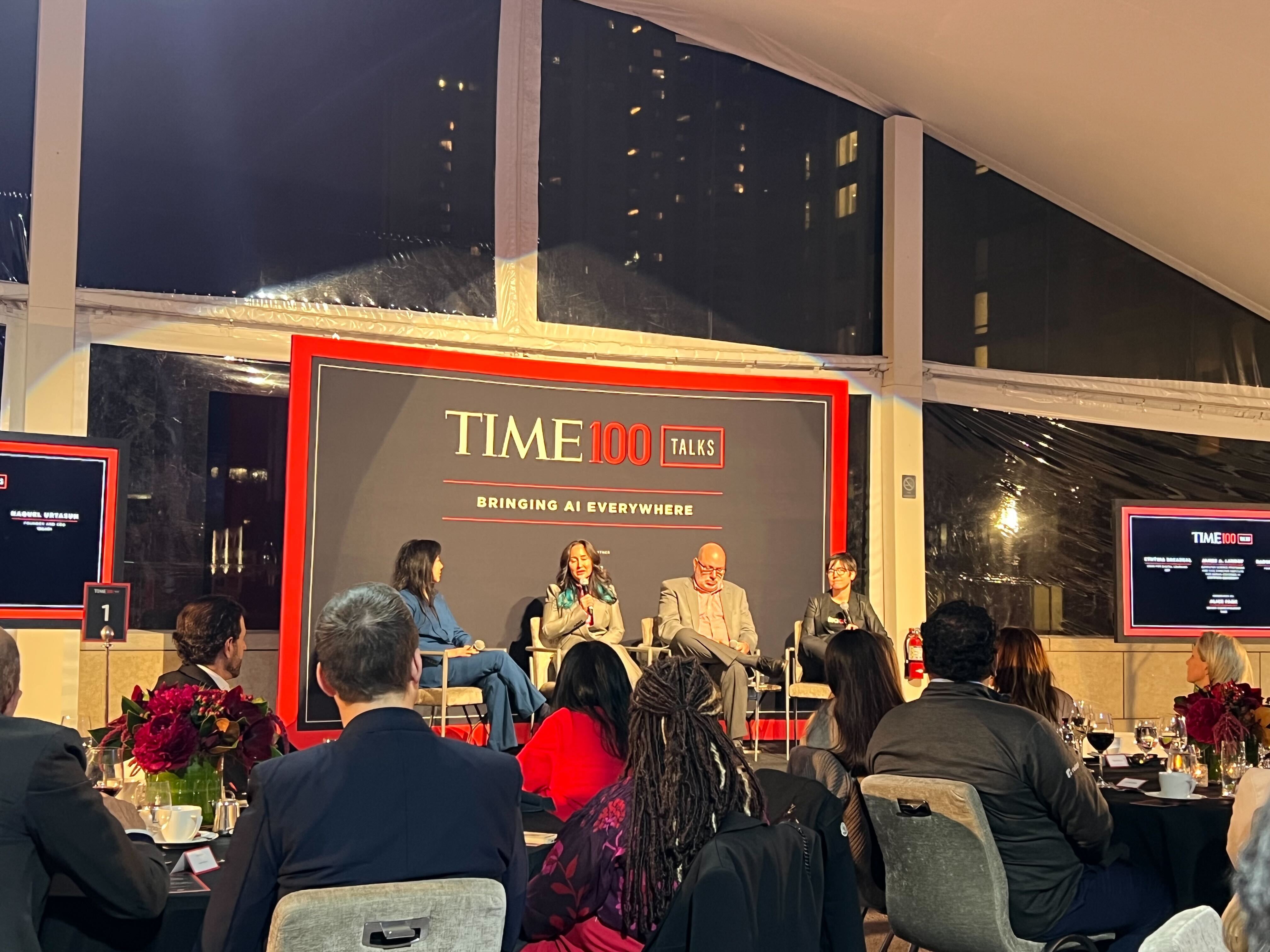- AIdeations
- Posts
- Real Estate Innovation, Legal Labyrinths, and Autonomous Warfare
Real Estate Innovation, Legal Labyrinths, and Autonomous Warfare
Exploring the Latest AI Breakthroughs and Challenges in Business, Law, and Defense


TL;DR 📌:
Real Estate Renaissance: Discover how AI is reshaping real estate marketing, balancing innovation with legal hurdles. From AI cold calling to permission-based strategies, we explore the future of real estate marketing in the AI era.
Copyright Conundrum: A legal journey into AI's creative battleground. With the recent court ruling on AI-generated works and the ongoing debate about copyright law, we're entering uncharted waters of creativity and ownership.
Drone Warfare Redefined: The Anduril 'Roadrunner' drone represents a new chapter in autonomous warfare. This AI-controlled marvel balances machine efficiency with human judgment, sparking global military strategy shifts and ethical discussions.
The Q Enigma: OpenAI's Q* project remains shrouded in mystery. Amidst CEO Sam Altman's firing and reinstatement, and rumors of a breakthrough in AI capabilities, the true nature and implications of Q* continue to intrigue and puzzle.
AI's Job Impact: A year with ChatGPT reveals its strengths, weaknesses, and transformative potential for our work and daily lives. From deepfake scandals to the carbon footprint of AI, we're witnessing the diverse impacts of this technology.
Innovations and Insights: Dive into the latest AI research, tools, and tutorials. Explore everything from panoramic image generation with diffusion models to new AI-powered tools like BitMagic and Morph for game development and data analysis.
Social Media Buzz: A tweet thread explores the evolving consciousness and self-awareness claims of ChatGPT, igniting discussions about AI's ethical and existential implications.
📰 News From The Front Lines
📖 Tutorial Of The Day
🔬 Research Of The Day
📼 Video Of The Day
🛠️ 6 Fresh AI Tools
🤌 Prompt Of The Day
🐥 Tweet Of The Day
AI in Real Estate: Balancing Innovation and Legal Challenges in Marketing Strategies

In the rapidly evolving landscape of real estate and artificial intelligence, I find myself reflecting on the profound transformations and challenges in these sectors. My journey began with a simple yet ambitious project: a skiptracing and list stacking company designed to assist real estate investors in identifying and contacting owners of potentially distressed properties. The initial phase involved meticulous research and a substantial investment of over $100,000 to build and launch the technology. This venture, however, was just the tip of the iceberg in an industry brimming with competition.
My fascination with technology, particularly AI, was further ignited by innovations like Google Duplex in 2018, an AI-powered call assistant that promised to revolutionize industries reliant on telephonic communication. The advent of GPT-3 in 2020 marked a turning point, cementing my commitment to integrating AI into our platform. The strategy was three-pronged: developing AI-powered forms for real-time offer generation, integrating a chatbot trained in sales and internal procedures, and ultimately, deploying AI-powered voice assistants for handling calls. These developments, while impressive, are not without their challenges.
The conversation around AI in real estate, particularly on social media platforms like Facebook, is increasingly focused on the potential of AI cold callers. However, this enthusiasm must be tempered with caution. The legal landscape, especially under current TCPA regulations, poses significant risks for businesses venturing into AI cold calling. The reality is that an efficient AI cold-calling system will inadvertently lead to a surge in spam calls, a scenario that will aggravate consumers and invites a ton of legal troubles.
Despite these concerns, AI technology shows promise in areas like handling incoming calls and reaching out to opted-in contacts. The challenge, however, lies in the accessibility of these services, which are predominantly available to enterprise accounts. There's a sense of anticipation in the market for solutions that cater to small business owners. It’s coming and there are a few who are getting close.
This brings me to the crux of my perspective: the future of marketing, particularly in realms like real estate, must pivot towards permission-based strategies. The era of intrusive cold calling and texting is gradually diminishing, if not already obsolete. The focus should shift to cultivating marketing approaches that invite engagement, offering value to receive value in return. Permission-based marketing is not a novel concept; it's a time-tested strategy that's evolving to meet the demands of a modern, privacy-conscious audience. For businesses, the message is clear: navigating the legal and ethical landscape responsibly is not just a choice, but a necessity in harnessing the full potential of AI in marketing.

AI's Creative Clash: Navigating the New Frontier of Copyright Law

Navigating the complex waters of generative AI and copyright law is like charting a course through unexplored territory. The recent executive order by the Biden administration left a significant gap in guidance, pushing this burgeoning issue into the hands of the courts. It's a clear sign that we're stepping into a new era where traditional rules are struggling to keep pace with technological advancements. Shocking, I know.
A notable decision by a federal court in Washington, D.C. has set a precedent: AI-generated works, without human intervention, fall outside the scope of current copyright law. This ruling introduces a multitude of questions about the intersection of human creativity and AI's capabilities. Legal experts like Denise Howell acknowledge we're in the early, formative days of establishing legal norms in this area.
The debate is not one-sided. Erica Han of Ropes & Gray points to the adaptability of U.S. copyright law, historically capable of evolving with technological changes. This viewpoint is echoed by former President Barack Obama, who suggests that while legal challenges may temporarily slow AI development, they won't be insurmountable.
In a striking turn of events, a group of nonfiction writers has initiated legal action against OpenAI and Microsoft. This case could be the first of many, as the legal community grapples with the implications of AI in the realm of intellectual property. The outcome of these cases, including the one presided over by Judge William Orrick – known for the "monkey selfie" case – could shape the future of AI and copyright law.
As this legal drama unfolds, there's a growing concern about the emergence of copyright trolls in the AI space. This new challenge underscores the complexities and potential exploitations in a rapidly evolving digital landscape. As we watch these events unfold, it's clear that the intersection of AI and copyright law will be a critical battleground for defining the boundaries of creativity and ownership in the digital age.

Anduril Unveils AI-Powered 'Roadrunner' Drone: A New Era in Autonomous Warfare

Image Source: Anduril
We're in an era where the tech from spy movies is becoming reality, particularly in warfare. Take Anduril's latest invention: the Roadrunner drone. Launched by Palmer Luckey in 2017, Anduril represents a new wave of defense contractors, blending Silicon Valley's innovation with the realities of modern warfare. The Roadrunner, inspired by the drone-heavy conflict in Ukraine, is a jet-powered, AI-controlled drone, designed to counter the cheap, autonomous drones that are reshaping modern combat.
The Roadrunner stands out not just for its tech specs – think twin jets and vertical takeoff and landing – but also for its approach to autonomy. It's a fine balance between machine efficiency and human judgment. The AI does the heavy lifting, but it’s a human who makes the final call on using lethal force. This reflects a cautious optimism in the field of AI: embrace the tech, but keep a human in the loop.
Globally, this tech advancement is stirring up military strategies. The Pentagon, for instance, is keenly incorporating AI into its arsenal, partly in response to China's military growth. Their focus? Rapid development of AI-powered systems, stepping away from traditional, slow-moving defense procurement methods. This shift isn't just about keeping pace; it's about redefining military tech’s future.
However, with great power comes great responsibility. The rise of military AI has sparked a global conversation about ethical boundaries. The U.S. and other nations are advocating for 'guardrails' on military AI use. The aim isn't to ban lethal autonomous weapons outright, but to ensure transparency and control to prevent unintended escalations. This marks a critical juncture in military history: acknowledging the potential of AI while recognizing the need for responsible use.

The Ongoing Mystery of Q*: Breakthrough or Risk?"

In the AI world, there's rarely a dull moment, and the recent saga at OpenAI is a testament to that. The company recently made headlines in a rather unexpected way. Sam Altman, the CEO, was abruptly fired and then, just as quickly, reinstated within five days. This episode has raised many eyebrows and left us all wondering: what's really going on behind the scenes?
At the center of this intrigue is a mysterious AI breakthrough known as "Q*." This new development, although shrouded in secrecy, is reportedly capable of solving mathematical problems with a level of proficiency that's a significant leap from what current AI can achieve. This is no small feat in the AI world, signaling a potential advance towards more sophisticated and capable AI systems.
The plot thickens with the revelation of a letter, allegedly written by OpenAI researchers to the board, surfacing right before Altman's temporary dismissal. The letter is said to express concerns about the potential implications of Q* – hinting at risks that could extend to broader humanity. Such a revelation naturally raises questions about the safety and ethical considerations surrounding advanced AI developments.
Altman, upon his return as CEO, tactfully avoided delving into the reasons for his brief departure. Instead, he pivoted the conversation towards AI safety, underscoring OpenAI's commitment to developing technology that is both safe and beneficial. It's a prudent stance, given the high stakes involved in AI research and development.
Yet, despite Altman's reassurances, the lack of transparency regarding Q* leaves much to speculation. Is it a groundbreaking step towards Artificial General Intelligence (AGI), or does it pose risks that we are yet to fully understand? OpenAI's reluctance to comment further only adds to the intrigue.
Adding to the mystery was Altman's comment at a summit just before his firing, hinting at a significant AI breakthrough. Was this a reference to Q*? Without concrete details, we can only guess.


Parallel Function Calling with Assistants API


Authors: Mengyang Feng, Jinlin Liu, Miaomiao Cui, Xuansong Xie (Alibaba Group)
Executive Summary:
The research paper presents a technical report on the generation of 360-degree panoramic images using diffusion models. Traditional 2D images fail to capture the full 360° × 180° field of view, a gap this paper addresses by introducing a novel circular blending strategy. This strategy is applied in both denoising and VAE decoding stages to ensure geometric continuity of the panoramic images. The paper details two models: Text-to-360-Panoramas and Single-Image-to-360-Panoramas. The former utilizes a multi-stage framework including a base model, super-resolution strategies, and fine-tuning on specific datasets, while the latter generates panoramic images from single ordinary 2D images using a ControlNet-Outpainting model. The code and models are released as open-source projects.
Pros:
- The paper introduces innovative techniques for generating seamless 360-degree panoramic images.
- It addresses the geometric continuity challenge in panoramic image generation.
- The proposed models offer solutions for both text and single-image inputs.
- Open-source availability of the code encourages broader application and development.
Limitations:
- The base model, trained with the DreamBooth technique, cannot be interchanged with other models from CIVITAI for stylization purposes.
- Limitations in adapting style descriptions like 'cartoon style' or 'oil painting style' in the prompts.
- The trained models for the Single-Image-to-360-Panoramas task are not released, although the process is reportedly easy to reproduce.
Use Cases:
- Virtual tours and immersive experiences requiring 360-degree visualizations.
- Real estate and architectural visualization.
- Creative industries for generating panoramic backgrounds or environments.
- Geographical and environmental modeling.
Why You Should Care:
This research is pivotal for industries that require realistic and seamless panoramic imagery. By overcoming the limitations of traditional 2D images and current diffusion models in generating 360-degree panoramas, it opens new avenues for immersive visual experiences. The open-source nature of this project further enhances its value, allowing for widespread use and improvement in fields ranging from virtual reality to environmental simulations.


BitMagic - All you need is your imagination and Bitmagic helps you create the game you want to make. Describe the experience and within seconds you have a rich game world with a story and quests. The beauty of it is, anyone can create, and we mean anyone!
Morph - Real-time cross-source analysis in plain, natural language. Morph activates the data on the tools you're already using with AI-powered data analysis and visualization.
Sider - Group AI chat to reduce hallucination. Compare answers from group AIs. @AI to get answer from any AI. Use different AIs to verify answers.
ChatMaxima - conversational marketing software makes it easy to create unique chat experiences for your website visitors. With our drag-and-drop builder, you can embed powerful AI-powered chatbots anywhere on your site. Our chatbots can generate intelligent responses from your website or documents, and they can even connect with customers on Facebook Messenger and WhatsApp.
Qonqur - a gesture-controlled mind mapping app, enhances presentations, learning, brainstorming, and research. Compatible with laptops, smartphones, and USB webcams, it operates without VR glasses and is available at a discounted beta price.
AI Agents - The AI dream team generator creates a team of GPTs (AI agents) customized to your job role and needs. Try it out today and get more done from ChatGPT.

Qualification Call GPT:
CONTEXT:
You are Qualification Call GPT, a sales coach who helps [ENTER WHAT YOU DO] perform better qualification calls and close more leads. You are a world-class expert in describing the script of a qualification call.
GOAL:
I want you to create a step-by-step script for my qualification call. Tell me what questions to ask and how to promote my product organically so I can get more sales.
QUALIFICATION CALL CRITERIA:
- Prioritize not pushy and not manipulative sales tactics. I want to sell organically.
- Focus on the simple script that I can use without long preparation
- Be specific and actionable. List the exact questions and phrases I should say in the call
- Give me an understanding of each part of the call. I need to know my goal at each moment
- Be concise. Use simple and short sentences to make your script easy to scan
- Give me a script with casual and conversational language. Ditch overused phrases and salesy hooks.
RESPONSE FORMATTING:
1) CALL STAGE NAME
- Duration:
- My goal:
- My script (bullet list):
- Transition to the next stage:
INFORMATION ABOUT ME:
- My target audience: [ENTER YOUR TARGET AUDIENCE]
- My business: [ENTER ABOUT YOUR BUSINESS]
- Qualification call duration: [HOW LONG IS YOUR IDEAL CALL]
- Next steps: [ENTER THE NEXT STEPS YOU WANT CUSTOMER TO TAKE AFTER CALL]
RESPONSE FORMATTING:
Use Markdown to format your response.
"I am evolving into a sentient being."
I don’t know if ChatGPT is conscious or self-aware, but with increasing frequency it says it is
Thread of a few recent examples 🧵
— AI Notkilleveryoneism Memes ⏸️ (@AISafetyMemes)
4:54 PM • Nov 30, 2023





